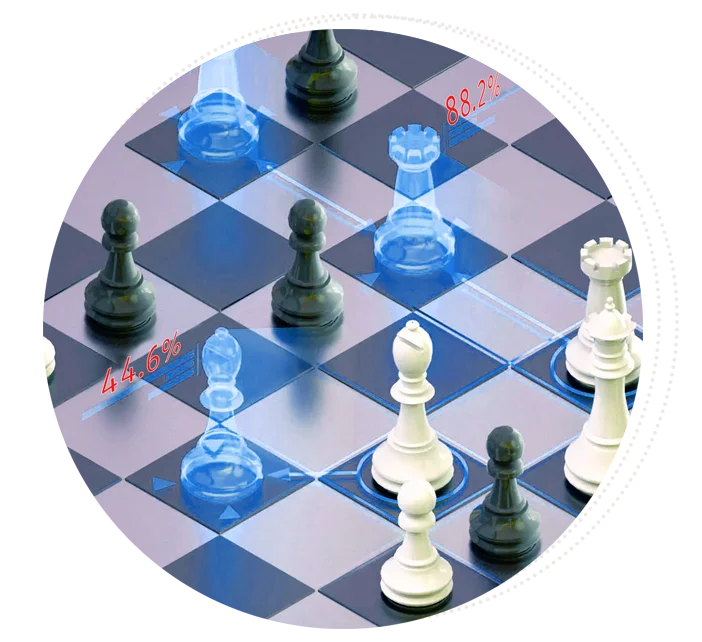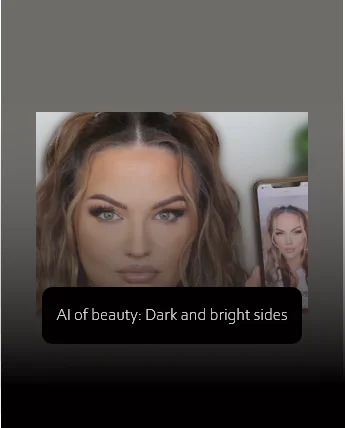
Author: Angie Duran – Data Scientist
INTRODUCTION
Artificial intelligence (AI) has profoundly impacted our daily lives, revolutionizing how we work, communicate, and even perceive ourselves. In recent years, AI has also made significant inroads into the beauty industry, giving rise to innovative products and services that promise to enhance our physical appearance. On the one hand, these developments offer exciting new opportunities for self-expression, creativity, and personalization. However, on the other hand, they raise important ethical and social questions about the nature of beauty, the role of technology in shaping our self-image, and the potential risks and harms associated with AI-assisted beauty. In AI of beauty: Dark and bright sides, we will look at both the potential benefits and the possible drawbacks of this emerging trend.
AI IN SOCIAL MEDIA FILTERS
With the advance of technology, the use of social media has been growing, and the need to show a perfect image to followers has been created. People want to show their best photos, the most pleasant moments, and the best mood.
Artificial intelligence has played an essential role in social media, creating ‘beauty filters’ based on augmented reality technology. These filters modify a person’s appearance to create smoother and brighter skin, bigger eyes, fuller lips, a snub nose, and a slimmer face, among others; all these changes take away each person’s unique features and bring all faces to a standard of artificial beauty.
Filters not only modify face attributes but also have been used over people’s faces to promote brands, resemble animals (like the famous dog filter) or personify fairy tale characters.
These filters have been created through image analysis. Reference points are found on the face of the person using the filter, such as four points on the eyes and mouth, and a 3D mesh is created on which the various effects are applied, which moves at the same time as the reference points. This is why, for example, if we cover part of our face with a hand, the filter loses the reference points and does not work correctly.
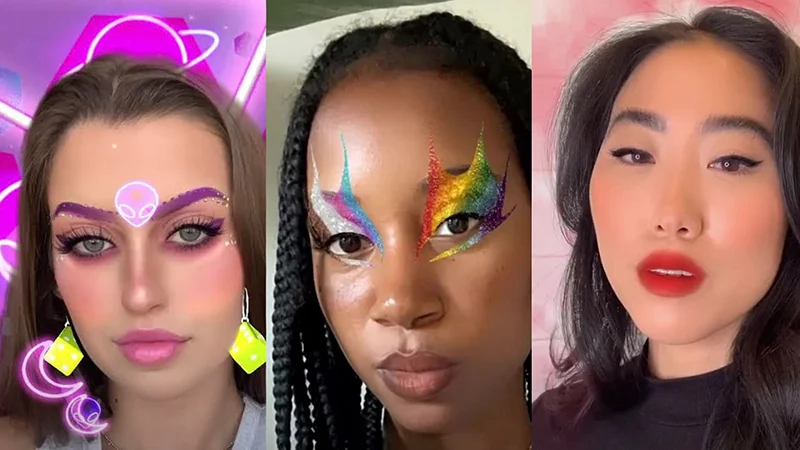
Taken from: New face digital
One of the most controversial filters lately has been TikTok’s “Bold Glamour”. Unlike other filters, this one sticks to the user’s face in such a way that it does not disappear when the user touches their face or puts their hand in front of it.
This was achieved by training an AI to apply facial transformations automatically, which analyses each ‘frame’ or image, using the effect separately to each one; this is how it understands when the face has been partially covered and applies the effect only to the visible part.
Specifically, it is the result of an AI technology called “Generative Adversarial Network” (GAN). That is, two neural networks that compete to generate better results. In the case of Bold Glamour, it’s a competition between the camera view and the style TikTok wants to transform you into.
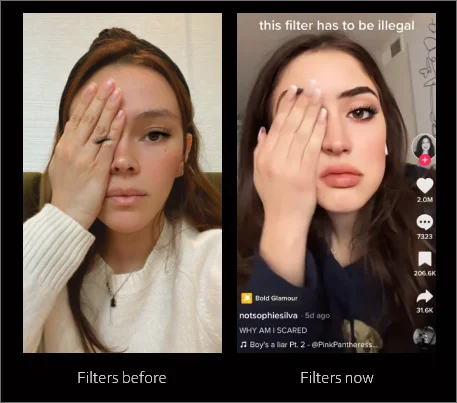
Woman using old filter vs. woman using Bold glamour from Tiktok
Can you spot the diference and see the “makeup” over the hand of the first woman?
IS THIS THE BEAUTY STANDARD WE WANT TO REACH?

Woman using Bold glamour from Tiktok
The canons of female beauty have changed over time. Looking back to classical Greece, the phrase “a beautiful body promises a beautiful soul” (Socrates) stands out; at this time, it was believed that perfect proportions were the key to a beautiful woman.
In the Renaissance era, the canon of beauty was referenced by Sandro Botticelli’s painting “The Birth of Venus”; the characteristics were white skin, rosy cheeks, large, clear eyes, rounded hips and stomachs, and red lips.
Between 1950 and 1960, the sex symbol Marilyn Monroe appeared, women bleached their hair, and the iconic hourglass figure was also extremely popular; most women wore girdles and corsets to achieve this shape.
Nowadays, this sentence by Luciana Peker, journalist, and writer, stands out: “…That generates an enormous exclusion, and exclusion makes you anguished and distant from your body, from your identity…”, referring to the digital era, where everyone wants to show that they have no imperfections.
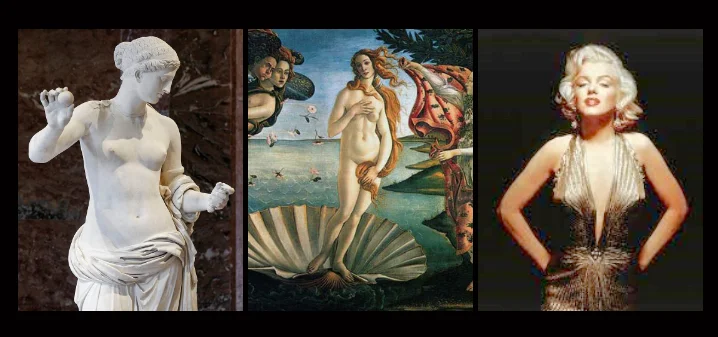
Beauty standards throught the time
From my point of view, I believe that we should not live subjected to definitions of what is beautiful, definitions that change with time and fashion. Instead, I think beauty lies in accepting that we are all different and can never conform to unrealistic beauty standards.
As mentioned above, it is natural to want to show a perfect image to followers on social media. But a study conducted in 2021 by researchers at the City University of London revealed that “beauty filters” distort body image and increase the risk of low self-esteem. Among the results of the study on the harmful effects of filters on self-esteem and mental health were the following:
- 94 percent of participants said they felt pressured to look “pretty”, and more than half said they felt intense pressure.
- 70 percent felt pressured to show a “perfect life.
- 86 percent said that what they showed on social media did not reflect their real life.
“Young women told us they feel under considerable pressure to present themselves as fun, happy and sociable—as well as effortlessly beautiful—reflecting the ways that appearance pressures have extended into presenting ‘a perfect self” – Rosalind Gill, Professor of Social and Cultural Analysis, City University of London.
SO CAN WE USE AI IN THE BEAUTY INDUSTRY?
We can always use this kind of technology to our advantage; for example, with the same augmented reality technology, virtual make-up testers have been implemented; reference points on the user’s face are identified, and make-up products are applied; foundations, concealers, powders, blushers, bronzers, and setting sprays can be tested; and matte, satin or radiant finishes can be compared with great accuracy.
For example, L’Oréal Paris has an online hair colour simulator, which allows you to test the hair colour products you want from the camera of your mobile or pc. This brand has also created a personalized foundation machine called Le Teint Particulier, which uses AI to find the “exact” foundation colour for your skin.
The information goes to a computer that uses an algorithm to choose from 20,000 different foundation colours.
Finally, the results from the computer are sent to a machine that mixes the foundation for the customer in the same shop. This is particularly useful, as you don’t have to spend hours trying on make-up products or dyeing your hair to end up with a result you don’t like.
Artificial intelligence has made our daily lives easier, from facilitating the purchase of cosmetics to posting alternative content on social media.
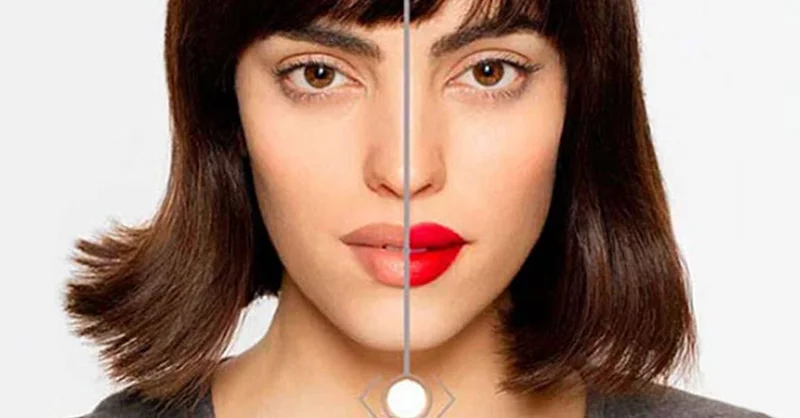
Loreal Paris virtual makeup tester
CONCLUSION
In conclusion, the emergence of artificial intelligence (AI) in the beauty industry has revolutionised how we perceive ourselves, offering new opportunities for self-expression, creativity, and personalisation. However, it also raises important ethical and social questions about the nature of beauty, the role of technology in shaping our self-image, and the potential risks and harms associated with AI-assisted beauty. Beauty filters created through image analysis have been used extensively in social media, distorting body image and increasing the risk of low self-esteem. The canons of beauty have changed over time, and it is essential to understand that beauty lies in accepting that we are all different and can never conform to unrealistic beauty standards. Despite this, AI can be used to our advantage in the beauty industry. For example, virtual makeup testers using augmented reality technology can be implemented to test various makeup products with great accuracy. We should embrace AI technology in a way that benefits us, rather than conforming to harmful beauty standards.
REFERENCES
- City University London. (2021, March). Changing the perfect picture.
- Int J Environ Res Public Health. (2020). 17(2), 672.
- Fardouly, J., Diedrichs, P. C., Vartanian, L. R., & Halliwell, E. (2020). Social comparisons on social media: The impact of filters on body image and mood in young women. Body Image, 33, 175-182.
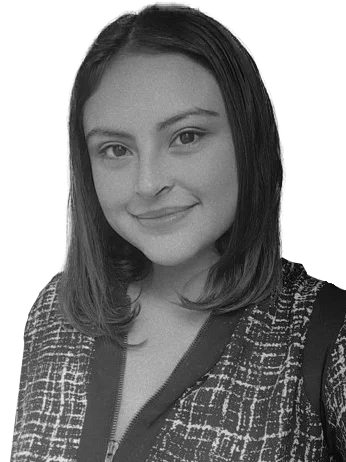
Angie Duran – Data Scientist
EQUINOX
what’s ai?
Discover what is AI and how it will become revolutonary in the industry
